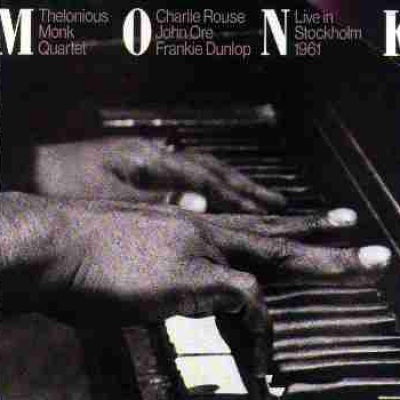
Live in Stockholm (1961)
"A lesson in jazz", wrote the Swedish jazz magazine Orkester Journalen after Thelonious Monk's two concerts in Stockholm on May 16, 1961. "Everything was so consistent and uniform, yet so varied", stated Bertil Sundin, and his co-critic Lars Werner, himself a jazz pianist with bebop roots, was equally enthusiastic: "He has complete control of his instrument which enables him to reach his goals." Carl-Erik Lindgren reviewed the concerts in the Swedish jazz magazine Estrad : "Monk manages to make every experienced listener of modern jazz uneasy by, without the slightest effort, avoiding commonplace phrasing. He also troubles you by playing so basically simple and obviously. He further disturbs you with his majestic dominance on stage, and one is entirely agitated when one hears the swing he projects his ideas with. This humble critic is also almost forgetting to say how beautifully he plays. Now, to the visual impression! Hardly anyone, no matter what he thinks about Monk, can avoid being somewhat shocked at his appearance on stage. He wore a cap during the first concert and a thick ski-bonnet during the second. This entrance into the classy Stockholm Concert House - had it been in the Swedish provinces, and a Swedish musician - would have caused a big scandal At the piano - an incomparable fervour, a musician who was enraptured! The sweat ran on his brow under his hats, his body swayed to and fro in convulsive jerks, his feet moved about as if they were in a cramp. Yes, Monk has mastered the art of visually captivating an audience". Bertil Sundin again: "He suddenly comes in on stage, with his hat on, doesn't look at the audience, stands in back of the piano so all you see is his legs, while the drummer plays an intro, then he sits down at the piano and the music just flows out! His entrance was a shock! The second tune "I'm Getting Sentimental Over You", it swung so much that one could hardly sit still." Lars Werner: "No, it was impossible, but what I thought was so fine in the first tune was ... the theme was always there. When Charlie Rouse played a solo, Monk used the theme as an accompaniment and later when he played solo, he he started with the theme and then made variations upon it - it was there all the time ... the rhythmical accents came again and again - - - Everything that Monk played was meaningful and thematic, never any lose ends." Everyone was not so enthusiastic, Estrad's Lars Resberg chose not to attend the concert because, as he wrote, it was about crippled, sick, comical jazz. But, anyway he reviewed the second concert that was broadcast on the Swedish Radio - and - he took the opportunity to put down not only Monk, but other critics who liked him, and fans as well: "Every town and community has its backward child, every village its idiot that the children mock with a fearful joy and make fun of. That was in yesteryear. Today we know better and can take care of our less fortunate friends and have an understanding of their difficult situations. That is to say, everywhere - with the exception of the world of jazz! Here we still cultivate a kind of degeneration of music, allowing each and all of us to experience and enjoy any kind of musical presentation. Monk's is a typical case - never in my life have I seen such "visual" reviews of any concert ..." Resberg could at least, by the side of the his radio, enjoy a formidable accompaniment and wonderful tenor by Charlie Rouse, But: "What about Monk when one is at a loss for the visual aspect of a hatted bop berserk? Yes, I recall what Harry Arnold said about Monk's solo recordings - Harry was right - "Monk can't play the piano, not as an accompanist or as a soloist" -- Embarrasing effects are more the rule than the exception - chromatic chord changes, whole tone scales, second intervals in absurdity. Thank heavens that there are other ways to enjoy jazz than this!" Thelonious Monk gave two concerts on this night, his appearance in Sweden. The warm-up band this Tuesday evening was Steffan Abeleen's Quintet, a young Swediah group which played in the Jazz Messenger style. Monk's both performances are here - completely - in the order the tunes were played. "One of our greatest jazz experiences", said Werner and Sundin. "I have never seen so many shocked critics and musicians after a concert, and it felt good to know that I was not alone in that respect", wrote Carl-Erik Lindgren.
